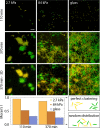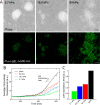Substrate stiffness impacts early biofilm formation by modulating Pseudomonas aeruginosa twitching motility
- PMID: 37158596
- PMCID: PMC10259483
- DOI: 10.7554/eLife.81112
Substrate stiffness impacts early biofilm formation by modulating Pseudomonas aeruginosa twitching motility
Abstract
Surface-associated lifestyles dominate in the bacterial world. Large multicellular assemblies, called biofilms, are essential to the survival of bacteria in harsh environments and are closely linked to antibiotic resistance in pathogenic strains. Biofilms stem from the surface colonization of a wide variety of substrates encountered by bacteria, from living tissues to inert materials. Here, we demonstrate experimentally that the promiscuous opportunistic pathogen Pseudomonas aeruginosa explores substrates differently based on their rigidity, leading to striking variations in biofilm structure, exopolysaccharides (EPS) distribution, strain mixing during co-colonization and phenotypic expression. Using simple kinetic models, we show that these phenotypes arise through a mechanical interaction between the elasticity of the substrate and the type IV pilus (T4P) machinery, that mediates the surface-based motility called twitching. Together, our findings reveal a new role for substrate softness in the spatial organization of bacteria in complex microenvironments, with far-reaching consequences on efficient biofilm formation.
Keywords: P. aeruginosa; colony formation; infectious disease; microbiology; physics of living systems; substrate stiffness; twitching motility.
© 2023, Gomez et al.
Conflict of interest statement
SG, LB, KJ, EC, DD, SL No competing interests declared
Figures























Comment in
-
Bacteria like it soft.Nat Rev Microbiol. 2023 Jul;21(7):413. doi: 10.1038/s41579-023-00917-y. Nat Rev Microbiol. 2023. PMID: 37217792 No abstract available.
Similar articles
-
Role of Cyclic Di-GMP and Exopolysaccharide in Type IV Pilus Dynamics.J Bacteriol. 2017 Mar 28;199(8):e00859-16. doi: 10.1128/JB.00859-16. Print 2017 Apr 15. J Bacteriol. 2017. PMID: 28167523 Free PMC article.
-
Material Substrate Physical Properties Control Pseudomonas aeruginosa Biofilm Architecture.mBio. 2023 Apr 25;14(2):e0351822. doi: 10.1128/mbio.03518-22. Epub 2023 Feb 14. mBio. 2023. PMID: 36786569 Free PMC article.
-
ChpC controls twitching motility-mediated expansion of Pseudomonas aeruginosa biofilms in response to serum albumin, mucin and oligopeptides.Microbiology (Reading). 2020 Jul;166(7):669-678. doi: 10.1099/mic.0.000911. Microbiology (Reading). 2020. PMID: 32478653 Free PMC article.
-
Biogenesis of Pseudomonas aeruginosa type IV pili and regulation of their function.Environ Microbiol. 2015 Nov;17(11):4148-63. doi: 10.1111/1462-2920.12849. Epub 2015 Jun 25. Environ Microbiol. 2015. PMID: 25808785 Review.
-
Effects of subinhibitory concentrations of macrolide antibiotics on Pseudomonas aeruginosa.Chest. 2004 Feb;125(2 Suppl):62S-69S; quiz 69S. doi: 10.1378/chest.125.2_suppl.62s. Chest. 2004. PMID: 14872002 Review.
Cited by
-
Life at the borderlands: microbiomes of interfaces critical to One Health.FEMS Microbiol Rev. 2024 Mar 1;48(2):fuae008. doi: 10.1093/femsre/fuae008. FEMS Microbiol Rev. 2024. PMID: 38425054 Free PMC article. Review.
-
Physical communication pathways in bacteria: an extra layer to quorum sensing.Biophys Rev. 2025 Mar 4;17(2):667-685. doi: 10.1007/s12551-025-01290-1. eCollection 2025 Apr. Biophys Rev. 2025. PMID: 40376406 Free PMC article. Review.
-
Bacterial Adhesion on Soft Surfaces: The Dual Role of Substrate Stiffness and Bacterial Growth Stage.Microorganisms. 2025 Mar 11;13(3):637. doi: 10.3390/microorganisms13030637. Microorganisms. 2025. PMID: 40142529 Free PMC article.
-
Carbon-Infiltrated Carbon Nanotube Topography Reduces the Growth of Staphylococcus aureus Biofilms.Nanomaterials (Basel). 2025 Mar 28;15(7):510. doi: 10.3390/nano15070510. Nanomaterials (Basel). 2025. PMID: 40214555 Free PMC article.
-
Rapid Stiffness Mapping in Soft Biologic Tissues With Micrometer Resolution Using Optical Multifrequency Time-Harmonic Elastography.Adv Sci (Weinh). 2025 Feb;12(8):e2410473. doi: 10.1002/advs.202410473. Epub 2024 Dec 16. Adv Sci (Weinh). 2025. PMID: 39686564 Free PMC article.
References
-
- Abidine Y, Laurent VM, Michel R, Duperray A, Palade LI, Verdier C. Physical properties of Polyacrylamide Gels probed by AFM and Rheology. EPL. 2015;109:38003. doi: 10.1209/0295-5075/109/38003. - DOI
-
- Aoudia N, Rieu A, Briandet R, Deschamps J, Chluba J, Jego G, Garrido C, Guzzo J. Biofilms of Lactobacillus plantarum and Lactobacillus fermentum: Effect on stress responses, antagonistic effects on pathogen growth and immunomodulatory properties. Food Microbiology. 2016;53:51–59. doi: 10.1016/j.fm.2015.04.009. - DOI - PubMed
-
- Armbruster CR, Lee CK, Parker-Gilham J, de Anda J, Xia A, Zhao K, Murakami K, Tseng BS, Hoffman LR, Jin F, Harwood CS, Wong GC, Parsek MR. Heterogeneity in surface sensing suggests a division of labor in Pseudomonas aeruginosa populations. eLife. 2019;8:e45084. doi: 10.7554/eLife.45084. - DOI - PMC - PubMed
-
- Beamish JA, Zhu J, Kottke-Marchant K, Marchant RE. The effects of monoacrylated poly(ethylene glycol) on the properties of poly(ethylene glycol) diacrylate hydrogels used for tissue engineering. Journal of Biomedical Materials Research. Part A. 2010;92:441–450. doi: 10.1002/jbm.a.32353. - DOI - PMC - PubMed
MeSH terms
Grants and funding
LinkOut - more resources
Full Text Sources

